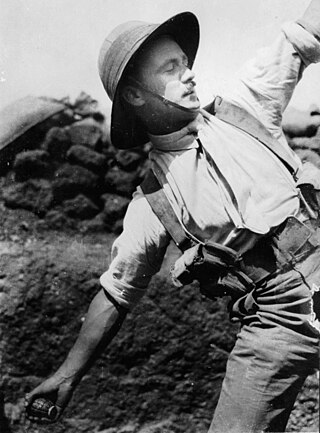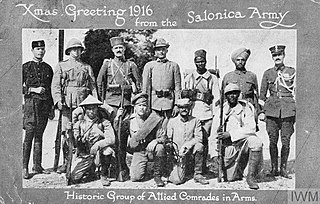
The Dardanelles, also known as the Strait of Gallipoli and in Classical Antiquity as the Hellespont, is a narrow, natural strait and internationally significant waterway in northwestern Turkey that forms part of the continental boundary between Asia and Europe and separates Asian Turkey from European Turkey. Together with the Bosporus, the Dardanelles forms the Turkish Straits.

The Gallipoli campaign, the Dardanelles campaign, the Defence of Gallipoli or the Battle of Gallipoli was a military campaign in the First World War on the Gallipoli peninsula from 19 February 1915 to 9 January 1916. The Entente powers, Britain, France and the Russian Empire, sought to weaken the Ottoman Empire, one of the Central Powers, by taking control of the Ottoman straits. This would expose the Ottoman capital at Constantinople to bombardment by Entente battleships and cut it off from the Asian part of the empire. With the Ottoman Empire defeated, the Suez Canal would be safe and the Bosphorus and Dardanelles straits would be open to Entente supplies to the Black Sea and warm-water ports in Russia.

The 29th Division, known as the Incomparable Division, was an infantry division of the British Army, formed in early 1915 by combining various Regular Army units that had been acting as garrisons around the British Empire. Under the command of Major-General Aylmer Hunter-Weston, the division fought throughout the Gallipoli Campaign, including the original landing at Cape Helles. From 1916 to the end of the war the division fought on the Western Front in Belgium and France.
The Mediterranean Expeditionary Force (MEF) was the part of the British Army during World War I that commanded all Allied forces at Gallipoli and Salonika. It was formed in March 1915, under the command of General Sir Ian Hamilton, at the beginning of the Gallipoli campaign of the First World War.

The British Salonika Army was a field army of the British Army during World War I. After the armistice in November 1918, it was disbanded, but component units became the newly formed Army of the Black Sea, and General Milne remained in command.

The Fifth Army of the Ottoman Empire or Turkish Fifth Army was formed on March 24, 1915, and dissolved on November 21, 1918. It was assigned the responsibility of defending the Dardanelles straits in World War I. The original commander of the army was the German military advisor to the Ottoman Empire, General Otto Liman von Sanders. The command passed to Vehip Pasha who became responsible for the Helles front while von Sanders still wielded considerable influence.
This article presents the timeline of the Gallipoli Campaign. The period of the proper battle is considered to be 19 February 1915 to 9 January 1916; however, a number of events took place between August 1914 and January 1915 that are relevant to the battle.

HMS Lord Nelson was a Lord Nelson-class pre-dreadnought battleship launched in 1906 and completed in 1908. She was the Royal Navy's last pre-dreadnought. The ship was flagship of the Channel Fleet when the First World War began in 1914. Lord Nelson was transferred to the Mediterranean Sea in early 1915 to participate in the Dardanelles Campaign. She remained there, becoming flagship of the Eastern Mediterranean Squadron, which was later redesignated the Aegean Squadron. After the Ottoman surrender in 1918 the ship moved to the Black Sea where she remained as flagship before returning to the United Kingdom in May 1919. Lord Nelson was placed into reserve upon her arrival and sold for scrap in June 1920.

Maurice Paul Emmanuel Sarrail was a French general of the First World War. Sarrail's openly socialist political connections made him a rarity amongst the Catholics, conservatives and monarchists who dominated the French Army officer corps under the Third Republic before the war, and were the main reason why he was appointed to command at Salonika.

The Macedonian front, also known as the Salonica front, was a military theatre of World War I formed as a result of an attempt by the Allied Powers to aid Serbia, in the autumn of 1915, against the combined attack of Germany, Austria-Hungary and Bulgaria. The expedition came too late and with insufficient force to prevent the fall of Serbia and was complicated by the internal political crisis in Greece. Eventually, a stable front was established, running from the Albanian Adriatic coast to the Struma River, pitting a multinational Allied force against the Bulgarian army, which was at various times bolstered with smaller units from the other Central Powers. The Macedonian front remained stable, despite local actions, until the Allied offensive in September 1918 resulted in Bulgaria capitulating and the liberation of Serbia.

HMS Agamemnon was one of two Lord Nelson-class pre-dreadnought battleships launched in 1906 and completed in 1908. She was the Royal Navy's second-to-last pre-dreadnought battleship to be built, followed by her sister ship, Lord Nelson. She was assigned to the Channel Fleet when the First World War began in 1914. The ship was transferred to the Mediterranean Sea with Lord Nelson in early 1915 to participate in the Dardanelles Campaign. She made a number of bombardments against Turkish fortifications and in support of British troops. Agamemnon remained in the Mediterranean after the conclusion of that campaign to prevent the German battlecruiser SMS Goeben and light cruiser Breslau from breaking out into the Mediterranean. Agamemnon shot down the German Zeppelin LZ-55 (LZ-85) during a bombing mission over Salonica in 1916. On 30 October 1918, the Ottoman Empire signed the Armistice of Mudros on board the ship while she was anchored at Lemnos in the northern Aegean Sea. She was converted to a radio-controlled target ship following her return to the United Kingdom in March 1919 and began service in 1921. Agamemnon was the last pre-dreadnought in service with the Royal Navy; she was replaced by Centurion at the end of 1926 and sold for scrap in January 1927.
The Armée d'Orient (AO) was a field army of the French Army during World War I who fought on the Macedonian front.

XII Corps was an army corps of the British Army that fought in the First and Second World Wars. In the First World War, it formed part of the British Salonika Force on the Macedonian front. In the Second World War, it formed part of the British Second Army during Operation Overlord and the subsequent North-West Europe Campaign of 1944-46.

The Battle of Krivolak was a World War I battle, fought between 21 October and 22 November 1915. It was fought in the initial stage of the Macedonian campaign, in the Balkans Theatre. On 21 October, Bulgarian troops attacked the French-held positions near the Strumica rail station, at the time part of the Kingdom of Serbia, starting the battle. Fighting continued until 22 November, when two Serbian divisions failed to capture Skopje, thus rendering the continuation of Entente offensive operations dangerous and forcing the French to evacuate their forces from the region.

The Corps Expéditionnaire d'Orient (CEO) was a French expeditionary force raised for service during the Gallipoli Campaign in World War I. The corps initially consisted of a single infantry division, but later grew to two divisions. It took part in fighting around Kum Kale, on the Asiatic side of the Dardanelles, at the start of the campaign before being moved to Cape Helles where it fought alongside British formations for the remainder of the campaign. In October 1915, the corps was reduced to one division again and was finally evacuated from the Gallipoli peninsula in January 1916 when it ceased to exist.

The Allied Army of the Orient (AAO) was the name of the unified command over the multi-national allied armed forces on the Salonika front during the First World War.

The Maltese Labour Corps (MLC) was a labour unit raised in Malta during the First World War to support the British Army. It comprised two battalions of labourers and stevedores; two companies of cooks, waiters, and servants; and a company of miners. The units served at Gallipoli, Salonika, Italy, and in Turkey. There may have been a further independent labour company that served in Malta. Many of the units' commanding officers were drawn from the King's Own Royal Malta Regiment of Militia. More than 5,000 men served in the corps, with members receiving the British War Medal in bronze. In the course of their service 124 members died, at least one killed in action with many of the remainder dying during the Spanish Flu pandemic of 1918.
156th Infantry Division was an infantry division of the French Army during the First World War. It was deployed overseas, seeing action during the Gallipoli campaign, and thereafter on the Salonika front, fighting alongside British troops in both theatres of war. It was sent to the Crimea in December 1918 as part of the Army of the Danube.
17th Colonial Infantry Division was an infantry division of the French Army during the First World War. It was deployed overseas, seeing action during the Gallipoli campaign, and thereafter on the Salonika front, fighting alongside British troops in both theatres of war. It was sent to the Crimea in December 1918 as part of the Army of the Danube.













